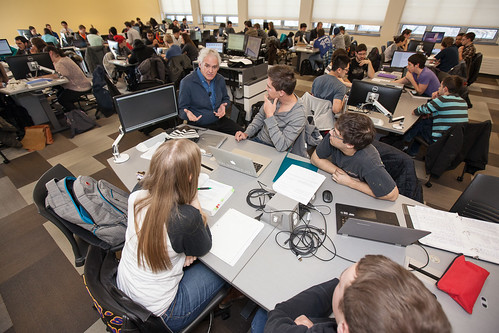This sense of threat is clearly described in an article in the journal Teaching in Higher Education, What does it mean to do teaching? A qualitative study of resistance to Flipped Learning in a higher education context (sadly not open access). It describes the implementation of a flipped learning approach in a teacher training programme at Macquarie University in Australia. The main benefit of flipped learning is that by switching the delivery of content to recorded lectures and demonstrations this will enable teachers to devote contact time to providing timely feedback, guiding, challenging and encouraging. The problem is that students have high expectations of the teacher as performer and see the flipped model as an abdication of responsibility. The stand-up lecture is seen as the definition of teaching - that's what teachers do. When that is withdrawn, the students feel cheated.
As indicated in the title of this paper, the Flipped Learning trial was met with resistance – in fact vociferous resistance. As I analysed data from the study and also reflected on my engagement with students during the delivery of the flipped course, a ubiquitous refrain emerged. Students drew persistent attention to an absence. In absenting from the traditional stand and deliver tutorial presence, I had denied my student’s access to the sage on the stage. My student’s indicated fear of missing out on critical information, discomfort of engaging in core content in asynchronous environments and resentment of what they understood as my absence in the tutorial (i.e. I was no longer sage on the stage but a guide to the side).
The students saw the method as at best interesting, but most commonly useless, time-consuming and confusing. The traditional lecture-based approach is seen as a way of guaranteeing that the necessary course material has been "covered" and that the students know what they have to learn for the exam.
The need to get the best exam grades to enhance future job prospects is the hard currency of higher education and pedagogic innovation sometimes clashes with these very pragmatic needs. This clash is demonstrated in another interesting article: Mediating Students’ Fixation with Grades in an Inquiry-Based Undergraduate Biology Course. Here students on a year one course in biology at Borealis University were studied as they worked through a redesigned course based on inquiry-based learning. Instead of the traditional lecture-based format, the students were expected to collaborate to investigate the main topics and reflect on the process.
... the curriculum required students to work cooperatively in groups to design and execute experiments that are authentically novel, gather and analyze data, and present their findings orally and in writing. Evaluative criteria included rubrics for transferred skills, and summative assessments for acquisition and application. Scientific concepts of uncertainty, peer review, and self-reflection were explicit parts of the design.This approach has been shown to lead to deeper learning as well as learning vital skills of search skills, source criticism, collaboration and self-reflection, but the results show a serious mismatch between the teachers' well planned approach and the students' perception of teaching. As in the first example, the students were vociferous in their criticism of the course methods and were especially critical that the experiment seriously threatened their chances of getting the top grades they need to progress in their career path. The teacher expected them to work things out for themselves and that was seen as an abdication of responsibility - the teacher is expected to go through the syllabus and make it clear to students exactly what they need to know to get a top grade.
Instructors who did not give explicit directions or answer questions directly were perceived as obstructionist. One student framed her professor’s response to her repeated requests for directions as adversarial, saying, “[The instructor] said, ‘You’re not gonna have a step by step. You need to figure it out.’ And I said, ‘Well, I’m sorry, but I’m not paying tuition to figure it out myself.’”
The article concludes that the extrinsic motivation of grades has a negative effect on the intrinsic motivation needed for an inquiry-based approach to succeed. The inquiry-based approach was designed to enhance student autonomy but the effect was the opposite - students felt cast adrift and powerless whereas in the traditional setting they felt more autonomous because it was clear what they had to do to achieve desired results. It's hard to be creative in a world governed by grades.
The key takeaway here is that any changes in course design have to be clearly communicated to the students and they need to know why the changes have been made and how it will benefit them. In this case the student expectations were completely at odds with the teachers' methodology. Maybe if you want to implement more collaborative methods you should introduce them in stages though the first year, slowly working towards collaborative learning rather than throwing the students in at the deep end. This means that all teachers in a programme have agreed on this progress and that each course is part of a progression towards greater autonomy and active learning.
References
Wilson, K. (2020) What does it mean to do teaching? A qualitative study of resistance to Flipped Learning in a higher education context, Teaching in Higher Education, DOI: 10.1080/13562517.2020.1822312
No comments:
Post a Comment
Note: Only a member of this blog may post a comment.